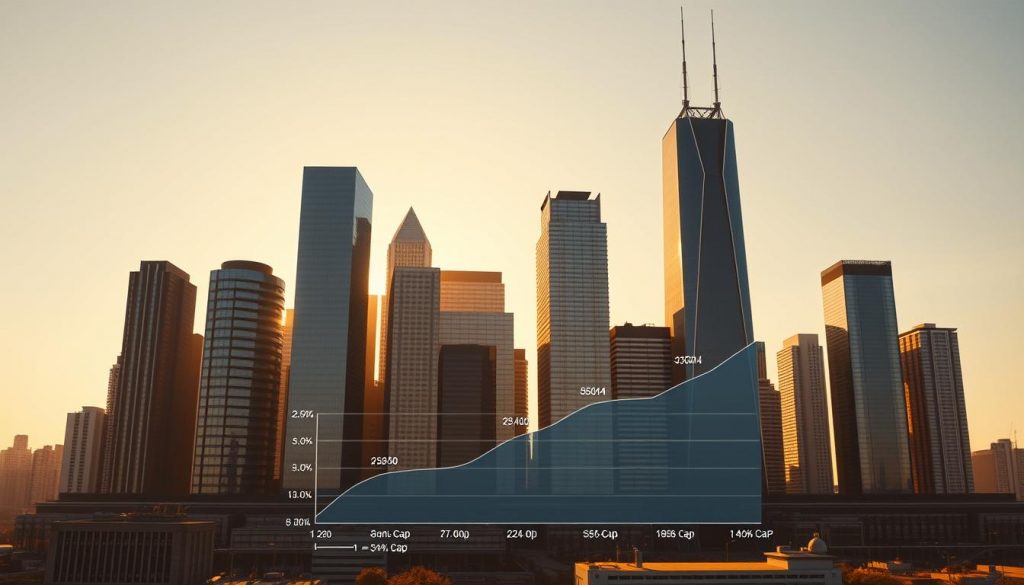Have you ever wondered why some companies are considered safer investments while others promise higher growth? The answer often lies in their market capitalization, a simple yet powerful metric that reflects a company’s size and potential. By understanding this concept, you can make smarter decisions in your investing journey.
Market cap is calculated by multiplying a company’s current share price by the total number of outstanding shares. For example, a company with 20 million shares trading at $100 each has a market cap of $2 billion1. This formula helps investors quickly gauge a company’s size and financial health.
Companies are often grouped into categories like large-cap, mid-cap, and small-cap based on their market cap. Large-cap companies, such as Apple and Microsoft, typically have a market cap of $10 billion or more, offering stability and lower risk. On the other hand, small-cap companies may have higher growth potential but come with increased risk2.
In this article, we’ll explore how market cap works, why it matters, and how you can use it to build a balanced investment portfolio. Let’s dive in!
Key Takeaways
- Market cap is calculated as share price multiplied by outstanding shares.
- It helps investors assess a company’s size and financial health.
- Large-cap companies are generally more stable but may offer slower growth.
- Small-cap companies can provide higher growth potential but come with greater risk.
- Understanding market cap is essential for building a diversified portfolio.
Introduction to Market Capitalization
Understanding a company’s size and value is crucial for making informed investment decisions. One of the most effective ways to gauge this is through market cap, a metric that reflects a company’s total worth in the financial world.
Defining Market Capitalization
Market cap is calculated by multiplying a company’s share price by the total number of outstanding shares. For example, a business with 1 million shares trading at $50 each has a market cap of $50 million3. This formula provides a quick snapshot of a company’s size and financial standing.
This metric helps investors compare companies across different industries. It also serves as a proxy for understanding a company’s stability and growth potential. Larger companies, like Apple or Microsoft, often have a market cap above $10 billion, indicating lower risk4.
Overview of Its Role in Successful Investing
Market cap plays a vital role in categorizing companies into groups like large-cap, mid-cap, and small-cap. Large-cap companies are typically more stable, while small-cap companies may offer higher growth potential but come with increased risk3.
For instance, a small-cap company with a market value between $250 million and $2 billion might be more volatile but could deliver significant returns over time3. On the other hand, a large-cap company like Walmart, with a market cap of $399.3 billion, is often seen as a safer investment4.
By understanding market cap, investors can build a diversified portfolio that balances risk and reward. For more insights on how company size influences investment strategies, check out this detailed guide.
The Role of Market Capitalization in Investment Decisions
When evaluating investments, one key factor often stands out: company size. This is where market cap comes into play. It helps us assess a company’s overall value and its potential for growth or stability. By understanding this metric, we can make smarter decisions about where to allocate our resources.
Assessing Company Value
Market cap is a straightforward yet powerful tool for evaluating a company’s worth. It’s calculated by multiplying the share price by the total number of outstanding shares. For example, a company with 10 million shares priced at $50 each has a market cap of $500 million5. This formula gives us a quick snapshot of a company’s size and financial standing.
Larger companies, often referred to as large-cap, typically have more resources for expansion and dividends. Smaller companies, or small-cap, may offer higher growth potential but come with increased volatility5. By analyzing market cap, we can better understand a company’s position in its industry and its potential for long-term success.
Implications for Our Investment Risk
Market cap also plays a crucial role in assessing risk. Larger companies are generally considered more stable, making them a safer choice for conservative investors. Smaller companies, while riskier, can deliver significant returns over time5.
For instance, a mid-cap company with a market value between $2 billion and $10 billion might strike a balance between growth and stability5. Understanding these categories helps us build a diversified portfolio that aligns with our risk tolerance and financial goals.
| Category | Market Cap Range | Risk Level | Growth Potential |
|---|---|---|---|
| Large-Cap | $10B+ | Low | Moderate |
| Mid-Cap | $2B – $10B | Medium | High |
| Small-Cap | Less than $2B | High | Very High |
By incorporating market cap data into our strategy, we can better navigate the complexities of investing. Whether we’re seeking stability or growth, this metric provides valuable insights to guide our decisions.
How to Calculate Market Cap
Calculating a company’s worth is simpler than you might think, and it all starts with understanding its market cap. This metric gives us a clear picture of a company’s size and financial standing, making it a cornerstone of investment analysis.
The Basic Formula Explained
The formula for market cap is straightforward: share price multiplied by the total number of outstanding shares. For example, if a company has 20 million shares trading at $100 each, its market cap is $2 billion6.
This calculation helps us quickly assess a company’s value and compare it to others in the same industry. It’s a tool every investor should have in their toolkit.
Real-Time Estimation and Practical Examples
Market cap isn’t static—it changes with fluctuations in share price and the number of outstanding shares. For instance, if a company’s stock price rises from $50 to $60, its market cap increases accordingly6.
Another factor is share repurchases. When a company buys back its own shares, it reduces the number of outstanding shares, which can boost the share price and maintain or increase the market cap7.
Let’s look at a practical example. Company A has 300 million shares priced at $10 each, resulting in a market cap of $3 billion6. This shows how the formula works in real-world scenarios.
Understanding this calculation is essential for making informed investment decisions. It’s a simple yet powerful way to gauge a company’s value and potential for growth.
Categories of Market Caps and Company Sizes
Investors often categorize companies based on their size to better understand their potential. This grouping helps us evaluate their stability, growth opportunities, and associated risks. By breaking companies into categories like large-cap, mid-cap, and small-cap, we can make more informed decisions about where to invest.

Large-Cap, Mid-Cap, and Small-Cap Insights
Large-cap companies, valued at $10 billion or more, are often industry leaders. Examples include Apple and Microsoft, which offer stability and consistent dividends8. These companies are ideal for investors seeking lower risk and steady returns.
Mid-cap companies, with values between $2 billion and $10 billion, strike a balance between growth and stability. They often operate in expanding industries and provide a mix of risk and reward9.
Small-cap companies, valued between $300 million and $2 billion, are known for their higher growth potential. However, they come with increased volatility and risk9. For example, many small-cap firms are unprofitable, with over 40% falling into this category in 20248.
Understanding Micro-Caps and Nano-Caps
Micro-cap companies, valued between $50 million and $300 million, are often in early growth stages. They can offer significant returns but are highly volatile9. These companies are typically less established and may lack the resources of larger firms.
Nano-cap companies, with values below $50 million, represent the smallest segment. They are often niche businesses with limited market presence. While they can be high-risk investments, they may also provide unique opportunities for growth9.
Understanding these categories helps us build a diversified portfolio. By balancing large-cap stability with small-cap growth potential, we can manage risk while aiming for long-term success.
Market Capitalization: A Core Tool for Analyzing Share Prices
Analyzing share prices becomes more insightful when we consider the broader picture of a company’s total worth. While a high share price might seem impressive, it doesn’t always indicate a large company. Instead, the full market cap provides a clearer view of a company’s size and financial standing10.
Linking Share Price to Company Value
The share price is just one piece of the puzzle. To understand a company’s true value, we multiply the share price by the total number of outstanding shares. For example, a company with 10 million shares priced at $50 each has a market cap of $500 million10.
This formula helps us see why two companies with similar share prices can have vastly different sizes. A $100 share price might represent a small company with few shares or a large company with millions of shares10.
Analysts often use market cap-weighted indexes to assess overall market performance. These indexes give more weight to larger companies, reflecting their greater influence on the market11.
| Company | Share Price | Outstanding Shares | Market Cap |
|---|---|---|---|
| Company A | $50 | 10M | $500M |
| Company B | $100 | 5M | $500M |
| Company C | $200 | 2.5M | $500M |
By focusing on market cap, we gain a better understanding of a company’s true size and its position in the market. This approach helps us make more informed investment decisions10.
Incorporating Market Cap Data in Portfolio Strategies
Building a balanced investment portfolio requires understanding the role of company size in risk and reward. By leveraging market cap data, we can create a diversified strategy that aligns with our financial goals and risk tolerance.

Diversification Based on Company Size
Diversifying across different company sizes is essential for managing risk. Large-cap companies, like Apple and Microsoft, offer stability and consistent returns, making them a cornerstone of many portfolios12. Mid-cap companies provide a balance between growth and stability, while small-cap companies, though riskier, can deliver significant growth potential13.
For example, allocating a portion of our portfolio to small-cap companies can enhance overall growth. However, we must balance this with investments in large-cap companies to mitigate volatility13.
“Diversification is not just about spreading investments; it’s about strategically allocating resources to manage risk and maximize returns.”
Here’s how we can structure a diversified portfolio:
| Category | Allocation | Role |
|---|---|---|
| Large-Cap | 50% | Stability and consistent returns |
| Mid-Cap | 30% | Balanced growth and stability |
| Small-Cap | 20% | High growth potential |
By regularly reviewing and adjusting our asset allocation, we can ensure our portfolio remains aligned with our goals. This process involves monitoring market trends and rebalancing investments as needed13.
Incorporating market cap data into our strategy helps us build a resilient portfolio. It allows us to balance risk and reward, ensuring long-term success in our investment journey.
Evaluating Growth Potential and Risk Through Market Cap
Evaluating a company’s growth potential and risk profile is essential for making informed investment decisions. By analyzing market cap, we can better understand a company’s size, stability, and potential for growth. This metric helps us balance risk and reward in our portfolio.
Balancing Stability and Volatility
Large-cap companies, like Apple, offer stability and consistent returns. With a market cap of over $3.2 trillion, Apple is a prime example of a low-risk investment14. These companies are ideal for investors seeking steady growth and lower volatility.
On the other hand, small-cap companies often exhibit rapid growth but come with higher risk. For instance, companies with a market cap between $300 million and $2 billion can deliver significant returns but are more volatile15. This makes them suitable for investors willing to take on more risk for potential rewards.
Mid-cap companies strike a balance between growth and stability. With a market cap between $2 billion and $10 billion, they provide moderate risk and steady growth15. This category is ideal for those looking to diversify their portfolio without excessive risk.
“Understanding the balance between stability and volatility is key to building a resilient investment strategy.”
Here’s how we can evaluate opportunities based on market cap:
- Large-cap companies offer stability and consistent returns.
- Small-cap companies provide higher growth potential but come with increased risk.
- Mid-cap companies balance growth and stability, making them a versatile choice.
By incorporating these insights, we can build a diversified portfolio that aligns with our financial goals. Balancing large-cap stability with small-cap growth potential helps us manage risk while aiming for long-term success.
Advanced Insights into Market Cap Trends and Digital Currency Impact
The rise of digital currencies has reshaped how we think about value and investment opportunities. Traditional market cap calculations are now being adapted to fit the unique nature of cryptocurrencies, offering new ways to assess their worth and potential.
The Evolution of Market Caps in a Digital Age
Cryptocurrencies like Bitcoin have introduced innovative metrics, such as diluted market cap, to better reflect their total value. Unlike traditional companies, digital assets often have a fixed supply, making their valuation methods distinct16.
For example, Bitcoin’s market cap reached approximately $1.1 trillion in April 2021, showcasing its growing influence in the financial world16. This parallels the valuation of established companies but with added volatility and unique growth drivers.
Here’s how digital currencies are changing the game:
- New metrics like diluted market cap provide a clearer picture of cryptocurrency value.
- Bitcoin’s market cap often rivals that of major corporations, highlighting its significance16.
- Traditional investment strategies are evolving to include digital assets for diversification.
“The integration of digital currencies into mainstream finance is not just a trend—it’s a fundamental shift in how we perceive value and risk.”
As digital currencies continue to grow, their impact on traditional market cap analysis is undeniable. Investors are now considering these assets as part of a diversified portfolio, balancing stability with high-growth potential17.
Looking ahead, the methodologies for assessing value will likely evolve further. The rise of decentralized finance (DeFi) and central bank digital currencies (CBDCs) will shape the future of market cap calculations, offering new opportunities and challenges for investors18.
Conclusion
Making informed investment decisions starts with understanding a company’s total worth. Market cap is a key metric that helps us assess a company’s size and financial health. By calculating it using the formula share price × outstanding shares, we gain valuable insights into its value19.
Companies are grouped into categories like large-cap, mid-cap, and small-cap based on their size. These categories help us evaluate growth potential and risk. For instance, large-cap companies often offer stability, while small-cap companies can provide higher growth opportunities20.
By integrating market cap data into our strategies, we can build diversified portfolios that balance risk and reward. This approach ensures we make smarter investment decisions tailored to our financial goals.
Use these insights to navigate the world of investing confidently. Understanding market cap is a powerful tool for achieving long-term success.
FAQ
What is market capitalization, and why is it important for investors?
How do we calculate market cap?
What are the different categories of market caps?
How does market cap influence investment decisions?
Can market cap help us analyze share prices?
How can we use market cap data in portfolio strategies?
What role does market cap play in evaluating growth and risk?
How is market cap evolving in the digital age?
Source Links
- Market Capitalization: What It Means for Investors – https://www.investopedia.com/terms/m/marketcapitalization.asp
- What is market cap and how do you calculate it? | Fidelity – https://www.fidelity.com/learning-center/trading-investing/market-cap
- Market Cap Explained – https://www.finra.org/investors/insights/market-cap
- Market Capitalization – https://corporatefinanceinstitute.com/resources/valuation/what-is-market-capitalization/
- Market cap: Definition, uses & calculation – https://www.thrivent.com/insights/investing/market-cap-definition-uses-calculation
- Market Capitalization: The Complete Guide | FinanceTuts – https://www.financetuts.com/market-capitalization/
- What is Market Capitalization and How is it Calculated?- ICICI Direct – https://www.icicidirect.com/ilearn/stocks/articles/what-is-market-capitalization
- Market Capitalization: What It Is, Formula for Calculating It – https://www.investopedia.com/investing/market-capitalization-defined/
- What Is Market Cap? Defined and Explained | The Motley Fool – https://www.fool.com/terms/m/market-cap/
- What Is Market Capitalization? – https://www.marketbeat.com/financial-terms/market-capitalization-what-it-means/
- How to Use Market Capitalization to Evaluate a Stock – https://www.investopedia.com/ask/answers/042415/how-can-i-use-market-capitalization-evaluate-stock.asp
- Market cap explained: what it is and why it matters – https://www.ig.com/uk/investing-need-to-knows/market-capitalisation
- In portfolio building, no one size fits all | Vanguard – https://corporate.vanguard.com/content/corporatesite/us/en/corp/articles/portfolio-construction-principles-inform-possibilities.html
- Market Capitalization: Understanding a Company’s Value in the Stock Market – https://www.businessinsider.com/personal-finance/investing/what-is-market-cap
- Market Capitalization: How It Works And Its Formula | Bankrate – https://www.bankrate.com/investing/market-capitalization/
- Digital Currencies Go Mainstream – How to prepare – https://corporate.visa.com/content/dam/VCOM/global/services/documents/vca-digital-currency-paper-vf.pdf
- Advances in Digital Currency Experimentation – https://www.newyorkfed.org/newsevents/speeches/2022/nea221104
- Cryptocurrency Market Size, Growth & Trends Report, 2030 – https://www.fortunebusinessinsights.com/industry-reports/cryptocurrency-market-100149
- Market Capitalization | Formula + Calculator – https://www.wallstreetprep.com/knowledge/market-capitalization/
- Market Capitalization: Meaning, Importance & Formula | Finschool By 5paisa – https://www.5paisa.com/finschool/finance-dictionary/what-is-market-capitalization/




0 Comments